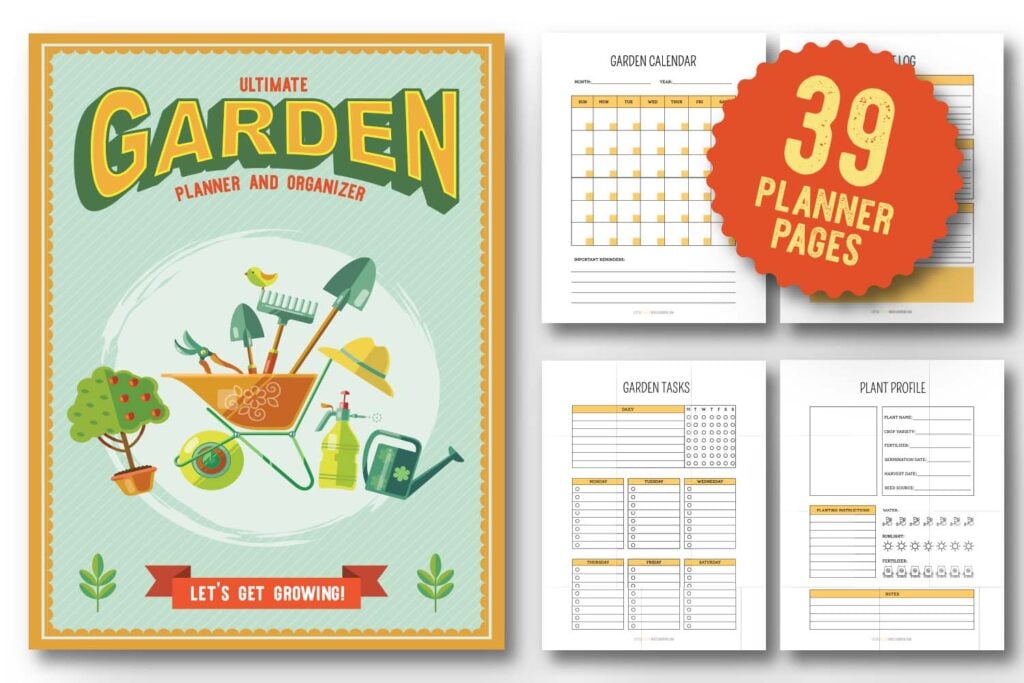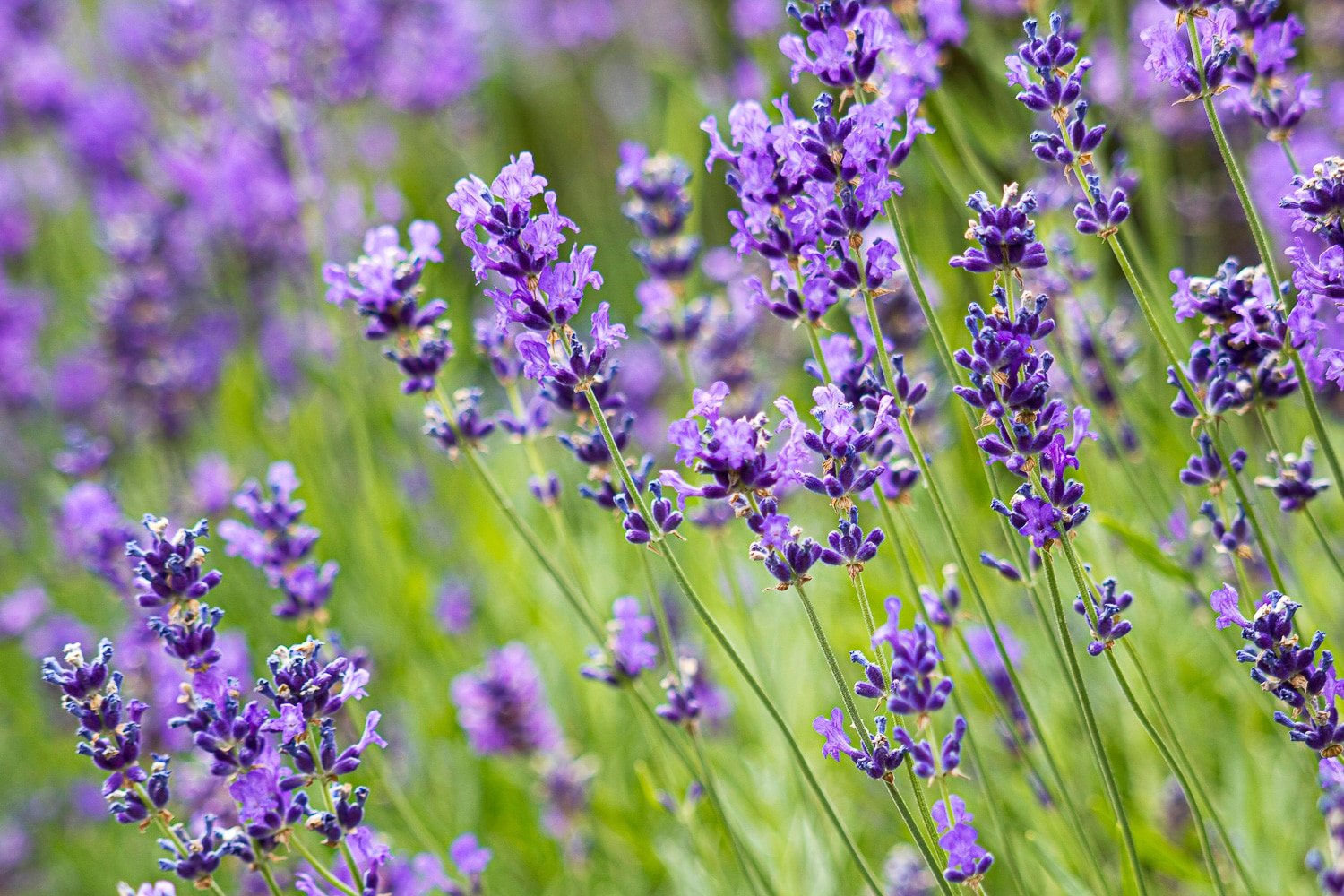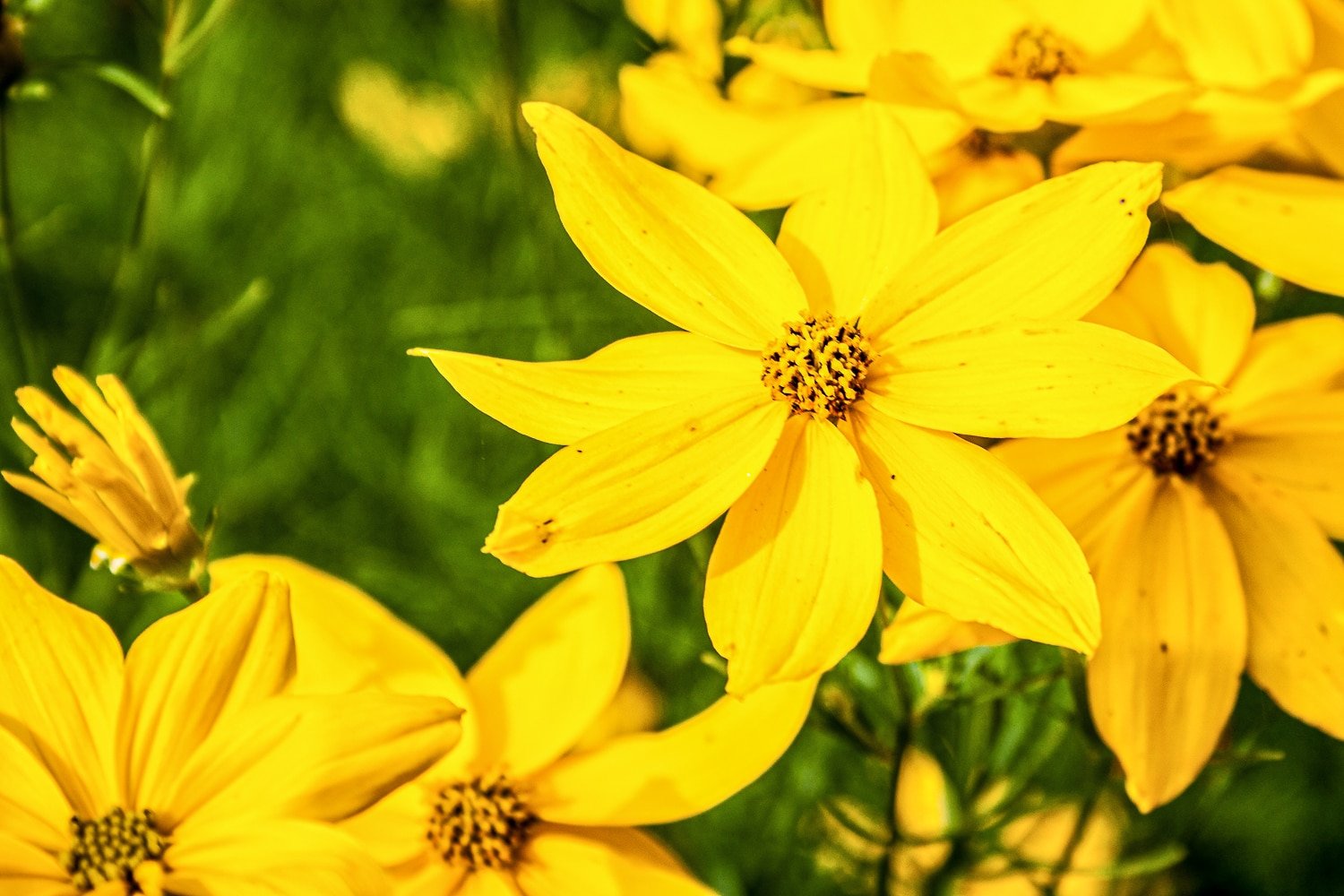26 Colorful Perennials That Bloom All Summer Long
Perennials offer a lot of bang for your buck. You plant them once, and they do what they need to do year after year. Most perennials will also create more plants by self-seeding or by divisions. And if you want even more value, plant the perennials that bloom all summer long. A few perennials planted now will bloom and multiply for years to come.
So what perennials last all summer long?
Our list below of long-blooming perennials contains old garden classics like rudbeckia, catmint, and coneflowers, shade flowering plants like astilbe, and even a few perennial flowering shrubs like hydrangeas. Our recommendations below will bloom all summer long, some with a bit of deadheading mid-season.
This blog post was so much fun to pull together. The images of these perennials got my seed-buying mojo running!

See our complete guide on fall planting perennials. It’s a great time to plant to reduce weeds, pests, and gardener frustration!
Flowers that stay bloomed All Summer long
There are so many wonderfully beautiful long lasting flowering perennials to choose from when it comes to planting in your garden. If you want big displays of flowers all summer long, you will want to check out the following list:
Bee Balm (monarda didyma)
Bees and butterflies flock to bee balm (also known as wild bergamot and Oswego tea). These long-blooming perennial plants have many clusters of tiny flowers that are abundant with nectar. Honey bees are particularly drawn to bee balm, as are butterflies and hummingbirds.
To grow bee balm in your gardens, plant it in rich, moist soil in a bright sunny location. Bee balm will tolerate shade in hot summers but flower better in full sun.
- Colors: pink, purple, red, and white
- Bloom time: July-September
- Zones: 3-9
- Height: 26-46 inches tall
- Sun Requirements: Full sun


Black Eyed Susan (Rudbeckia flugida)
Black-eyed Susan blooms all summer long and is drought tolerant, can be used as a natural dye, makes terrific cut flowers, and is deer resistant. By far, one of the hardest-working flowers in the garden.
- Colors: Bright yellow flowers
- Bloom time: July-September
- Zones: 3-9
- Height: 18-30 inches tall; 24-30 inches wide
- Sun Requirements: Full sun
Learn More: See our full guide on how to grow black-eyed Susans from seed. Black-eyed Susans also make great dried flowers, and we have a complete guide on how to dry flowers using five different methods to dry all your garden flowers.

Blanket Flower (gaillardia)
Gaillardia is a superstar in perennial flower beds with contrasting dark gray-green foliage and brilliantly bright orange and yellow blooms- the flowers pop!
Blanket flowers are a must-have if you are looking for long-blooming perennials for your garden beds or borders.
- Colors: Daisy-like flowers in combinations of red, yellow, and oranges.
- Bloom time: June- October
- Zones: 3-10
- Height: 2-3 feet tall; 2 feet wide
- Sun Requirements: Full sun

Butterfly Weed (asclepias tuberosa)
Butterfly weed is a native perennial prairie plant that will tolerate poor soil and is drought tolerant. The bushy plants are prized for their abundant clusters of bright orange blooms that attract droves of butterflies.
Butterfly weed is a milkweed and a critical food source for the monarch butterfly.
- Colors: Orange flowers
- Bloom time: June- August
- Zones: 4-9
- Height: 2-3 feet tall; 2 feet wide
- Sun Requirements: Full sun

Catmint (nepeta spp.)
Catmint (called catnip) is a bushy perennial herb with violet-blue flowers blooming all summer. Cats LOVE catnip and will roll on the plant if given the opportunity.
When in full bloom, the plants are stunning, with dense spire clusters of purple and blue that almost completely hide the lower foliage.
- Colors: Violet-blue
- Bloom time: June- August
- Zones: 3-8
- Height: 3 feet tall; 3 feet wide
- Sun Requirements: Sun to partial shade
Learn More: See our complete guide on growing catmint!

Coralbells (heuchera sanguinea)
Coralbells are sturdy, low-growing perennials that produce delicate bell shape flowers on stems that rise above the dark green foliage.
To prolong blooms, be sure to deadhead spent flowers. Coralbells do best in cooler climates and may not rebloom in warmer southern regions.
- Colors: Pink, white, and red.
- Bloom time: (late spring)from May to June (but will reflower well into summer if deadheaded)
- Zones: 3-8
- Height: 15-18 inches tall; 12-18 inches wide
- Sun Requirements: full sun to partial shade
Learn More: See our complete guide on growing coralbells.

Daylilies (hemerocallis spp.)
The easiest perennial to grow in summer, Daylily is true to its name. It has yellow, orange, or red-brown flower buds that open at sunrise. The trumpet-like flowers are borne in multiples on solid stems and will rarely be without blooms during the growing season.
Daylilies will require daily deadheading to keep the plants blooming all summer.
- Colors: Creams, yellows, oranges, peaches, salmon, and maroons.
- Bloom time: June- August
- Zones: 3-9
- Height: 1-4 feet high; 1.5 feet wide
- Sun Requirements: Full sun but will tolerate light shade

Goatsbeard (astilbe spp.)
Astilbes are wonderful perennial plants for shade gardens. The individual flowers of Astilbe are pretty small, but they appear densely on plume-like clusters.
Plant these lovely feathery flowers in perennial borders and wild shade gardens.
- Colors: White, pink, and purple
- Bloom time: June- August
- Zones: 5-8
- Height: 2-4 feet high; 2 feet wide.
- Sun Requirements: Shade

Geranium Rozanne
Rozanne is one of the longest-blooming geraniums, blooming from June until October. When other geraniums are dying down mid-summer, Rozanne keeps flowering nonstop.
These bushy purple flowering plants make an excellent ground cover or an addition to a perennial border. The plants are sterile and will not self-seed, so there is no worry about the plants taking over garden beds.
- Colors: Violet-blue flowers with a white eye
- Bloom time: June- August
- Zones: 5-8
- Height: 15-20 inches tall;2-3 feet wide
- Sun Requirements: Full sun but will tolerate part shade.

Hollyhocks (alcea rosea)
Hollyhocks are my favorite biennials/ perennials that bloom all summer. Their tall, majestic spires in full bloom are something I look forward to every year. They are the quintessential cottage garden perennial, and their gorgeous flowers attract hummingbirds and butterflies in droves.
The huge blooms make lovely cut flowers for big, bodacious displays.
The plants are biennial but self-seed so readily that they perform like perennials.
- Colors: Range of shades from creamy whites, yellow, pinks, reds, and maroons.
- Bloom time: June- August
- Zones: 3-8
- Height: 3-8 feet tall – 3-4 wide: Plant at the back of a perennial garden or against a south-facing wall or fence.
- Sun Requirements: Plant in the sun for best performance.

Hydrangeas
Hydrangeas are small flowering shrubs with huge balls of papery blossoms that bloom all summer. They make lovely foundation plantings or hedgerows. They also make excellent cut flowers and look perfect at home in a cottage garden.
Hydrangeas used to be once-per-season bloomers. However, the new varieties on the market can now bloom all summer.
Sadly hydrangeas are deer candy. Deer will eat the stems, flowers, blooms, and leaves, decimating bushes in a single feeding. If deer are not a problem in your garden, hydrangeas are a must-have addition!
- Colors: pink, blue, greenish cream, and red
- Bloom time: July-September
- Zones: 3-9
- Height: 26-46 inches tall
- Sun Requirements: Full sun in colder regions, partial shade in warmer ones.
Learn More: See our article on the best flowering shrubs to plant for curb appeal.

Ice Plant
Ice Plants bloom in carpets of 2-3 inch daisy-like flowers in bright colors that appear to shimmer in the sun as if covered with ice crystals. The plants bloom so prolifically that the flowers cover and hide the foliage.
Ice Plants are very drought-tolerant and can handle poor soils. Use this beauty in a rock or terraced garden and allow the plants to cascade and tumble.
- Colors: Bright purple, pink, or yellow daisy-like flowers.
- Bloom time: June-September
- Zones: Pink, red, purple, yellow, orange
- Height: 3-6 inches tall; 1-3 feet spread
- Sun Requirements: Full sun

Lavender (lavandula angustifolia)
Lavender is a must-have herbaceous perennial. The plants produce heavily scented flowers and can be used for cooking, body care products, cut flowers, and dried flowers. But lavender benefits don’t end there. The plants are also drought-tolerant and deer resistant!
Lavender attracts bees, butterflies, and other beneficial insects to the garden, making it a great addition to pollinator gardens! The aromatic plant also makes an excellent companion plant for the vegetable garden.
- Colors: Purple flower spikes
- Bloom time: June to July, but will reflower if deadheaded after the first bloom to keep the flowers going all summer.
- Zones: 5-9
- Height: 12-24 inches tall; 24 inches wide
- Sun Requirements: Full sun
Learn More About Lavender:

Lupine (Lupinus sp.)
There are several types of lupines, from wild varieties to hybrids. You will want to look for Russel hybrids for your garden beds and borders.
Lupines bloom in early summer and produce flowers on tall spires. However, the plants will do best in cooler zones as intense heat will limit their summertime performance.
- Colors: Cream, yellow, red, blue, Purple, pink, and white flowers
- Bloom time: Late spring until late summer
- Zones: 4-8
- Height: 3-4 feet with a spread of 2 feet
- Sun Requirements: Full sun
Learn More: Check out our full guide to growing lupins!

Beardtongue (Penstemon barbatus)
There are several species of beardtongue, but P. barbatus is the hardiest and will bloom all summer. Pentstemon is known for its tall spires of attractive flowers in soft pastels of blue, pink, lavender, white and bright poppy reds.
Most penstemons begin flowering in late spring and continue through summer. If flowers are cut back at the end of summer, they may have an additional flush of blooms.
- Colors: Pastel blues, pink, lavender white, and bright scarlet reds.
- Bloom time: Late spring to fall
- Zones: 3-9
- Height: 1-3 feet tall
- Sun Requirements: Sun to partial shade

Phlox (phlox paniculata)
Phlox is one of the most versatile and gorgeous flowering perennials, ranging from low-spreading moss phlox to tall cottage garden varieties.
Garden phlox or border phlox have large trusses of fragrant flowers that bloom from summer until early fall. They also grow very well in pots and containers.
Remove spent flower heads to keep plants tidy and prevent reseeding.
- Colors: shades of pastels-whites, reds, purples, oranges, and pink flowers.
- Bloom time: July-Sept
- Zones: 4-8
- Height: 3-4 feet tall; 2-3 feet wide
- Sun Requirements: Full sun

Purple Coneflower (echinacea purpurea)
Purple coneflowers are long-blooming perennials that are easy to grow and provide masses of blooms with little care. Strong stems produce daisy-like flowers with dropping purple petals sounded by a distinct raised central cone.
These traditional purple flowering perennials are also available in white, yellow, and bright hot pink colors.
Coneflowers are drought-tolerant, deer and squirrel resistant, and self-seed quite prolifically. These flowers look divine, planted with Black-eyed Susans in a perennial border. They also provide food for bees and butterflies and are excellent for cutting flowers.
- Colors: Purple, pink, and white
- Bloom time: All summer long
- Zones: 3-9
- Height: 3-4 feet tall; 1.5-2 feet wide
- Sun Requirements: Full sun

Red Hot Poker (kniphofia spp)
Also called torch lily or poker plant, these long-blooming tall perennial plants bloom with impressive flower spikes, often with vivid colors.
Use in the back of a garden bed, in full sun but do protect these plants from wind.
In northern zones, protect the plants with a heavy layer of mulch before winter.
- Colors: Red, orange, yellow, and white flowers
- Bloom time: Summer until late fall
- Zones: 3-8
- Height: 2-4 feet tall; spread of 1-2 feet
- Sun Requirements: Full sun
Learn More: Deer will avoid eating Red Hot Poker, making it a great perennial in areas where deer are a problem. Check out our full list of deer resistant perennials here.

Russian Sage (perovskia atriplicifolia)
Russian sage is a bushy-looking perennial plant with stunning bluish-purple flowers with silvery gray foliage. Also, the flowers bloom so much that it is difficult to see the leaves and foliage. This perennial is very deer and drought resistant.
Plant Russian sage in dry, warm conditions with good soil. Add Russian sage to craggy gardens, or add them to perennial borders with other drought-tolerant plants.
- Colors: Purple, blue
- Bloom time: Late June until early fall.
- Zones: 5-9
- Height: 2-3 feet tall
- Sun Requirements: Direct sun is best
Learn More: Did you know Russian Sage is used as a natural blue fabric dye? We have a whole list of flowers you can grow in your gardens to make natural homemade fabric dyes.

Sage (salvia officinalis)
Salvias love the sun and heat; the more daylight provided, the better these perennials bloom.
Sage blooms with pretty spikes of blue/ purple flowers, creating beautiful displays. These lovely perennials will grow in any well-draining soil.
Plant sage in direct sun in rocky gardens, perennial herb gardens, and perennial borders with other drought-tolerant plants.
- Colors: Purple and blue
- Bloom time: Summer to fall
- Zones: 3-8
- Height: Up to 2.5 feet
- Sun Requirements: Full sun
Learn More: See our article on how to grow sage from seed – and learn all about the different types of sage, including their taste and usage.

Stonecrop (sedum spp.)
Stonecrop will flower in early spring when most flowers have not yet bloomed. The plants provide a vital food source for bees and butterflies when food sources are scarce.
All sedum species are fleshly leaved and tolerant of drought.
Plant sedum in well-draining soil in full sun for abundant displays of flowers.
Sedum works well in a perennial mixed border, garden beds, or used as an edging or container plant.
- Colors: Red, pink, cream, white, yellow, and rust
- Bloom time: Spring to late summer
- Zones: 3-8
- Height: 4 inches to 2 feet tall
- Sun Requirements: Direct sunlight is best
Learn More: See our guide on planting the best flowers to attract bees to your gardens.

Shasta Daisy (chrysanthemum x superbum)
Shasta daisies are unparalleled for producing a summer-long supply of happy white flowers with yellow centers. Double blooms are all white and sometimes ruffled.
Shatas are tolerant of heat and drought, and deer tend to avoid them. Plus, these summer-blooming perennials are low maintenance!
Please Note: Shasta daisies can be invasive, so check your region before you plant. To prevent the plants from self-seeding, remove flower heads before they can scatter.
- Colors: White
- Bloom time: Summer to late fall
- Zones: 4-9
- Height: 1-4 feet tall- 1.5-2.5 feet spread
- Sun Requirements: Full sun

Speedwell (Veronica spp)
Veronica has several species that range in size from ground cover to tall back-of-the-border type plants. These long-blooming perennials have blue spikey flowers, but white and pink are also available.
Veronica is drought resistant and grows well in warm regions. Speedwell will grow and look lovely in craggy rock gardens, used as edging (low-growing varieties).
- Colors: Blue, pink, and white
- Bloom time: June-September
- Zones: 4-9
- Height: 8 inches- 5 feet
- Sun Requirements: Full sun

Tickseed (coreopsis grandiflora)
Tickseed is a stunning bright yellow flowering bushy perennial with dark green foliage. The plants do require daily deadheading to ensure continuous summer flowers.
The plants are drought-tolerant but not long-lived and require very well-drained soil to survive winter in cooler regions.
Tickseed plants tend to grow for three seasons before requiring division.
- Colors: Bright yellow flowers
- Bloom time: June- August
- Zones: 4-9
- Height: 2-3 feet tall; 1 foot tall
- Sun Requirements: Full sun

Yarrow (achillea millefolium)
Yarrows are vigorous plants with large, tightly packed, flat flower clusters. Although the flower heads are tiny, the clustered blooms create a very attractive display.
Plant varieties of yarrows are bred for spaces like mixed garden beds and borders.
Yarrows also make fine additions to wildflower gardens.
Take note: Yarrow self-seeds vigorously – to stop the spread, remove spent flowers and seed heads before they scatter.
- Colors: Flatheads of white, red, and pink flowers
- Bloom time: June to late August or early September
- Zones: 4-8
- Height: 2-3 feet tall; 2 feet wide
- Sun Requirements: Full sun
Learn More: Learn everything you need to know to grow healthy yarrow plants in your own backyard.

Yellow Loosestrife (Lythrum punctata)
Loosestrife looks marvelous planted as a back-of-the-border anchor plant. It produces slender spires of yellow flowers from spring through summer if the summer temperatures are not hot.
Remove faded flowers to keep plants tidy and encourage longer blooming.
Yellow loosestrife is a moisture-loving plant and grows well in swampy soil, ditches, pond banks, and stream banks. However, check before you plant to ensure loosestrife is not invasive in your area.
- Colors: Yellow flowers
- Bloom time: June to late July, but proper deadheading will encourage a second flush of flowers in cooler regions.
- Zones: 4-8
- Height: 2-3 feet tall; 1-2 feet wide
- Sun Requirements: Full sun but does appreciate light shade in warmer regions.

Final Thoughts
I hope you’ve enjoyed reading about which perennials bloom all summer, and if you’re like me, this post will make you excited to get out and start planting!
Looking For More Flower Gardening Inspiration?

Author: Laura Kennedy
Writer & Owner of Little Yellow Wheelbarrow
Laura is a highly skilled gardener and fervent flower enthusiast. Despite her playful battle with plant spacing guidelines, Laura’s work inspires gardeners to create thriving, beautiful spaces that reflect both creativity and sustainability.













